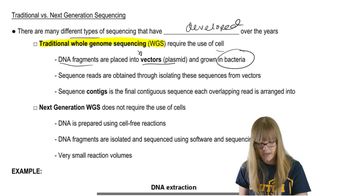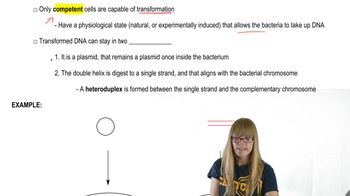Table of contents
- 1. Introduction to Genetics51m
- 2. Mendel's Laws of Inheritance3h 37m
- 3. Extensions to Mendelian Inheritance2h 41m
- 4. Genetic Mapping and Linkage2h 28m
- 5. Genetics of Bacteria and Viruses1h 21m
- 6. Chromosomal Variation1h 48m
- 7. DNA and Chromosome Structure56m
- 8. DNA Replication1h 10m
- 9. Mitosis and Meiosis1h 34m
- 10. Transcription1h 0m
- 11. Translation58m
- 12. Gene Regulation in Prokaryotes1h 19m
- 13. Gene Regulation in Eukaryotes44m
- 14. Genetic Control of Development44m
- 15. Genomes and Genomics1h 50m
- 16. Transposable Elements47m
- 17. Mutation, Repair, and Recombination1h 6m
- 18. Molecular Genetic Tools19m
- 19. Cancer Genetics29m
- 20. Quantitative Genetics1h 26m
- 21. Population Genetics50m
- 22. Evolutionary Genetics29m
5. Genetics of Bacteria and Viruses
Bacterial Transformation
Problem 29b
Textbook Question
Textbook QuestionA wild-type culture of haploid yeast is exposed to ethyl methanesulfonate (EMS). Yeast cells are plated on a complete medium, and 6 colonies (colonies numbered 1 to 6) are transferred to a new complete medium plate for further study. Four replica plates are made from the complete medium plate to plates containing minimal medium or minimal medium plus one amino acid4 (replica plates numbered 1 to 4) with the following results:
Identify the colonies that are prototrophic (wild type). What growth information leads to your answer?
 Verified Solution
Verified SolutionThis video solution was recommended by our tutors as helpful for the problem above
Video duration:
3mPlay a video:
Was this helpful?
Key Concepts
Here are the essential concepts you must grasp in order to answer the question correctly.
Prototrophy vs. Auxotrophy
Prototrophic organisms can synthesize all essential compounds from basic nutrients, while auxotrophic organisms lack the ability to produce certain compounds and require them to be supplied in the medium. In the context of yeast, identifying whether a colony is prototrophic or auxotrophic is crucial for understanding its growth on minimal media versus complete media.
Recommended video:
Guided course

Traditional vs. Next-Gen
Ethyl Methanesulfonate (EMS) Mutagenesis
EMS is a chemical mutagen that induces mutations in DNA, often leading to changes in gene function. In yeast, exposure to EMS can result in a variety of mutations, some of which may affect the ability to synthesize essential amino acids, thus impacting the growth of the yeast on different media types.
Recommended video:
Guided course

Induced Mutations
Replica Plating Technique
Replica plating is a method used to transfer colonies from one agar plate to another, allowing for the assessment of growth under different conditions. This technique helps in identifying prototrophic colonies by comparing their growth on complete medium versus minimal medium, revealing which colonies can survive without additional nutrients.
Recommended video:
Guided course

Proteomics

 5:53m
5:53mWatch next
Master Transformation with a bite sized video explanation from Kylia Goodner
Start learningRelated Videos
Related Practice


